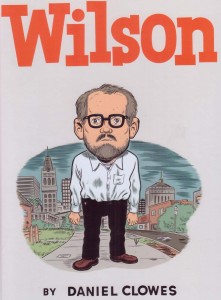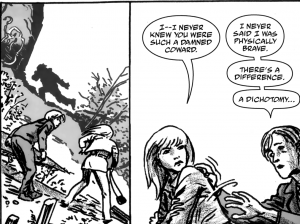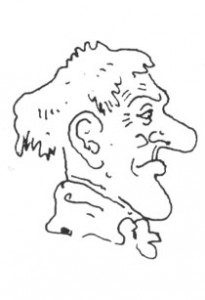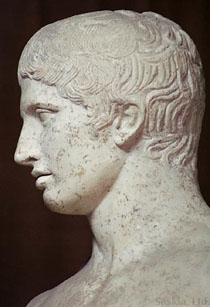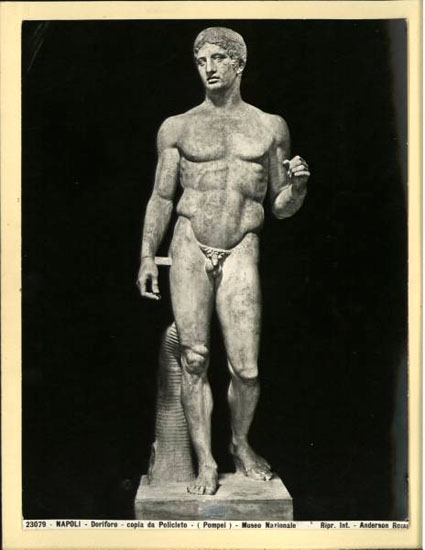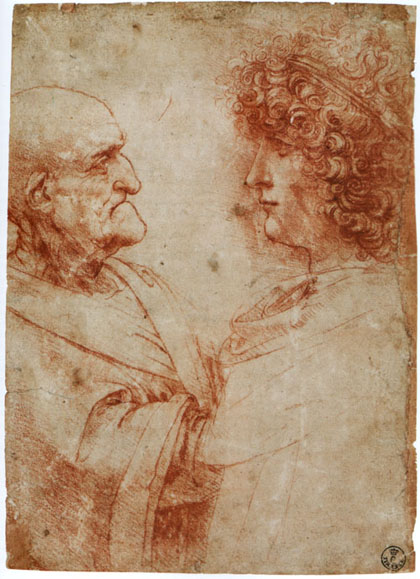In which our fair blogger talks a bit about her critical theory and new critical approaches.
It’s been a nicely theory laden past couple of weeks here at HU, and I’ve enjoyed seeing Noah and Caro argue Lacan and Freud and Foucault. Suat has his own lenses with which to approach comics: he’s always got some wonderful, surprising old comic art to reference and post in relation to whatever we’re peering at. Richard has a rich and interesting knowledge of capes and artists and writers and storylines. And our collaborators and columnists will no doubt have their own ways of thinking or talking about art.
And then there’s me, wandering around being snobby about manga art and sticking my tongue out at Clowes and rolling my eyes at Alan Moore and generally being, I suspect, a bit odd.
In watching the different critics talk about their work as critics, I’ve been thinking about my own stance and my own influences. I’m familiar with some of the modern critical thinkers like Lacan and Freud, but I don’t particularly find them interesting. I don’t find the old critical thinkers like Aristotle all that interesting either. To me, they’re one voice, and to be honest, these single voices are too…. I’m not sure what.
Dull? Un-interactive? Non-collaborative?
Maybe if I was able to argue with Caro and Noah about Lacan, he’d become more interesting, but since Lacan makes my eyes glaze and I end up saying things like “‘m awake, really, just resting my eyes there for a second, um what?” it wouldn’t be a very interesting conversation.
But what has occurred to me, over time, is that while I don’t have that conversation, I am still busy having critical conversations. And these other critical conversations seem both omnipresent and invisible (isn’t everyone having these conversations right now? No? What do you mean no?)
And these conversations inform everything I write and very much inform how I approach the art in question. So I’m going to talk a bit about the critics I’m wandering around soaked in and what that means for me as a comics blogger and then I’m going to talk about a new project. Ahem.
So these conversations that I’m having, that I participate and read and revel in, come in a variety of forms but are in general created over at the great morass of feminine critical art thought that is LiveJournal. Fandom, yes, I’m talking about fandom. There’s a whole weird, complicated set of social rules, mores, and activities in fandom but at the moment, we’re having several interesting conversations, as one does at a big party, and it helps to think of the critical thought as something of a salon and a collaborative effort.
Instead of an icon like Lacan, I think of broad topics with a twisting path of conversational threads, often centered around either wank or a communal discussion of a notable issue. So it’s, say, the Gabaldon Wank this past week, and in that wank, we’ve been talking about fanfic versus profic, how art is created (ie, not in a vacuum), authorial rights, porn, BDSM in published works, why gay characters always have to be evil/sadistic/die/fuck the opposite sex, and whether Marion Zimmer Bradley got screwed over by fanfic (answer: no).
Now, I understand that every community has conversations like this, and it seems as though of some of these topics are discussed via forums or blogs in comics, but one of the most notable aspects of the fandom I run in is two things: One, there’s a lot of private conversations (locked, so, like private parties) where people refine their ideas amongst friends and can talk more freely and two, there’s a lot of effort put into truly collaborative linked, meta works so that the conversation can be read as a whole.
There are individual people who gather links and then post them to create a new conversation (with or without their own take), there are communities whose sole purpose is to find interesting critical posts and wrangle the links together (like MetaFandom), there are communities where the links are wrangled and then new conversations take place (like Unfunny Business or FandomWank), there are wikis, and on and on. It’s all based on the idea that many people are having a group discussion and that the group discussion itself is worthy of note, and that anyone may join in at any time and be of interest.
This is not to portray fandom as a nice place, because it isn’t. It’s kind of like getting a lot of sharks together and tossing in a penguin to play with. Manga critics: not nice people!
But this is a very much a difference from, well, the folks who run things round these here parts. I remember reading the “welcome” post from the head honcho here, Gary Groth, (who I’d never heard of) and being shocked at the rudeness and also the lack of buy-in, to use an annoying business term. He doesn’t think the web provides useful or interesting criticism. And he said so in his welcoming post to his new online critics!
Odd.
In my neck of the woods, you never know who will be the next awesome commentator or the coolest writer or the worst troll. Could be anyone (there was an infamous incident of a TV producer getting banned once, fer instance). Conversations of note aren’t just a few of the same people talking, but tend to get metafandomed and then spread like wild fire until posts reach many hundreds of comments and the poster has to take a valium and go offline for a few days (not a joke, and I have seen this happen several times). Sharks, like I said. Also manga critics: still not nice.
It leads to some fascinating theory. You can read posts like How to Suppress Discussion of Racism which was brought about by fandom discussions of various artistic works. That’s easily recognizable as theory and criticism.
But there are other aspects to the weird world of fandom. One aspect that I love is that nothing is sacred. Fandom writers write about, work with, and criticize everything. TV fans talk about comics, comic fans talk about audio books, book fans talk about commercials, real person fans talk about music, it’s all mashed up and spun around and shaken not stirred. And it makes for some, well, pretty weird art.
Because, like its approach to critical theory, fandom thinks pretty much anyone can play in the sandbox and use whatsoever tools they’ve got lying around to create art. Want to read one of the best takes on a gay relationship between two characters on a TV show? Read about them as GirlScout cookies in a multi-media piece here. Not work safe. Yes, you read that correctly. Not safe for work gay cookie porn. It’s got over nine-hundred comments and it’s really, really good. Trust me!
But that’s the thing about fandom. You can love TV today and comics tomorrow. Or love comics and then love TV. You can use your powers as a lawyer or as a sculptor or, god save us, a knitter. Podcasts. Videos. Audiobooks. Comics. Novels. Poems. Theories. Archives. Charity auctions. Social networking code. Anything and everything rolled into one big, gooey pile of confusion and collaboration.
I suspect that most of the critical comics world doesn’t know about fandom’s take on comics (manga or American) because fandom is so damn messy, and wading through a thousand and one posts on Adam Lambert’s hair or Rape Culture 101 doesn’t appeal to them, or feels irrelevant or uninteresting. Fandom blogs are a lot less single-focus than comics blogs seem to be. My own blog, while sometimes discussing modern class theory as shown in fantasy and SF, is currently discussing nail polish.
Just as a for instance.
But the mismash of media makes for a lot of interesting art. It means that feelings, themes, plots, and characters are re-interpreted and re-invented time and again by many people in many ways. Art that started out as a TV show becomes a written and drawn comic. Comics become stories. Novels spur audiobooks. And comics, including modern American mainstream comics, become perfume.
Oh yes. Perfume. Officially licensed , commercially sold perfume.
This is not like that wretched Spiderman lip gloss crap. (GROSS, people. GROSS. Do. not. want.) That was an attempt by The Powers That Be to commercialize a product that would appeal to girls just in order to make some random bucks. Hint: speaking as a girl, if you can’t match MAC’s lipglass, I ain’t touching it, and I’m sure as heck not putting anything associated with Spidey’s goo near my lips. Ew.
No, what I’m talking about is a re-imagining of the comic, the characters, through a different sense entirely. What is Hellboy as a scent, rather than a visual image or written story?
Which is the question I shall be addressing in my upcoming posts. What is the Hellboy character as a scent? What is the comic? How are they related, and when the scent is realized, what emotions does it evoke? How successful are such imaginings?
Black Phoenix Alchemy Lab‘s perfumes are well known in fandom circles and are usually referred to as BPAL. They’re a small perfumer, working in tiny batches, handmixed, and without a major in-person retail outfit. The scents themselves have quite a fandom following on their own, but one of the most fascinating aspects of BPAL is the way that they explore imagery, ideas, and characters through scents. For a long time, they have had a series of perfumes that evoke places, Shakespearean characters, Lovecraftian horrors, Alice in Wonderland, and deities. They have also explored art pieces as scents, as in the Salon series. (There was also a limited edition floating world series, but it’s gone now.)
When I mentioned the idea of this series to Noah, he seemed startled, but encouraged me to proceed. “Truly bizarre”, in his words. I think it’s a bit difficult to startle Noah and I’m quite pleased to have managed it. In my world, switching from medium to medium is quite common, and can result in some truly spectacular art. Or some truly eye searing horrors, such as the infamous Care Bear BDSM story (which I would like to forget thankyousoverymuch).
What this means is that I will be exploring comics and scent. Comics re-imagined in a new sense, literally, from the visual and verbal to the sensory input of the nose. Hellboy. Witchblade. Neil Gaiman’s works. Boom Studios. Sachs and Violens.
I don’t know all of these comics, so I’ll be reading them and smelling them at the same time. I’m curious, as some of the folks around here have no doubt actually read all of the comics in question, if anyone has favorite characters whose scents they’d like to see reviewed or explored. Are there characters you think I’d find particularly intriguing? Is anyone already familiar with these scents and have a favorite? Is BPAL completely new to you? Have you experienced comics in a different medium yourself that you’d recommend I check out (such as, I don’t know, the comic fandom version of cookie porn?) as I go through this exploration of re-imagining?
Or, you know, do you now need a valium and a lie down after finding out about the Care Bear thing?

